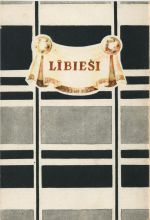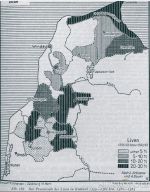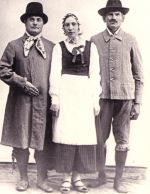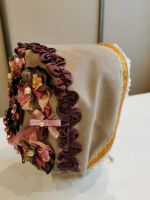This foldout features illustrations of a full women's folk costume and various details:
- brunu raksts (skirt weave pattern),
- lakata stūris (headscarf corner),
- krekla shēma (blouse schematic),
- kakla rota (necklace),
- cepures shēma (hat schematic), and
- cepures mugurpuse (back, or nape, of hat),
and descriptive overviews in French, English, Russian, and Latvian.
Lībieši, Livonians aka Livs
Livonians or Livs, lībieši in Latvian, are neither a Latvian people, nor are they associated with a specific locality such as a parish or town. Instead, the Livs are the Finno-Ugric brethren of the Estonian and Finns, historically inhabiting Latvia's coastal areas and up the Daugava river valley.
While the Liv language is being preserved, Liv is no longer used by anyone in their daily life as a native speaker — a sad development given Peters' mother fondly recalled singing Liv songs with her friends in Kurzeme (Courland) in her youth.
The Livs busied themselve with coastal fishing, agriculture and animal husbandry, with fishing being the most important, catching herring, sardines, flounder, and cod. Their catch was then smoked and preserved. Fishing continued to be a vital economic activity into the early 20th century.
Beekeeping, beyond gathering naturally occuring honey, came to be practiced in the mid-19th century. After Latvia gained its independence, many Livs along with the rest of Latvia's citizenry became small farmers as Latvia's de-industrialization during WWI and its War of Independence forced Latvia into an agriultural economy.
Folk costume
Livs wore traditional folk garb into the 19th century. However, they adopted street clothes earlier than other inhabitants of Latvia, thus few folk costumes from that time have been preserved. Men were first to transition, while women held on to traditional dress particularly for going to church and celebrations such as weddings.
Women wore tunic-style shirts, jackets or bodices and skirts. The earliest pleated skirts had vertical stripes, with two colored ribbons sewn to the hem. Liv women also wore villaines. woolen shawls. At the end of the 19th century, ancient white villaines were still worn, but colorful seģenes (woven square scarves with fringes around the edges) had become more common. In cool, rainy weather, Liv women donned so-called half-pleated or coverlet skirts on their shoulders — just like ordinary pleated skirts, only wider. Liv women preferred factory-made silk, cotton or fine wool scarves, tied about the head or worn over the shoulders. Married women wore a cap on their head with a beautifully decorated nape of the neck — with brocade and silk ribbons, pieces of fabric and glass beads. Liv women also wore a mouth cloth, the so-called mundaga, a white, long scarf that covered the cheeks and chin and was tied at the back of the head. For celebrations, women also put on a fine and white apron made of purchased cloth.
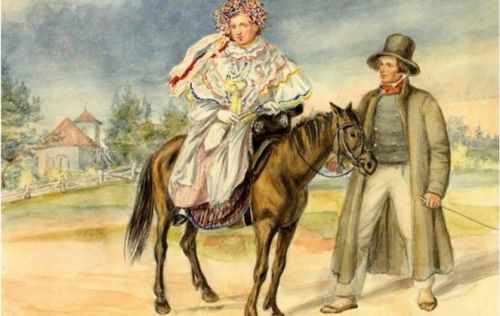
Men wore shirts, trousers and suit-type jackets. Pants were mostly knee-length come springtime. They wore socks on their feet, which were tied with a prievīte (typically a woven patterned ribbon) below the knee. Liv men were fond of short jackets. Long jackets, worn less often, were pulled over short ones as a coat. Jackets had no buttons, instead, a belt was worn around the waist. In winter, Livs wore sheepskin coats with wool on the inside. Notably, having adopted street clothes earlier than other contempraries, in 1930, in support of cultural and social development, the time had come to resurrect the Livs' ancient garb. In large measure, newly sewn folk costumes preserved 19th century traditions, other than some unmarried women chose to wear the ornate "married" aube, cap.
Read more
| 1 | Ancient Liv lands include Ventava in Kurzeme (Courland), where Peters' family comes from on his father's side. |
 Gallery
Gallery
